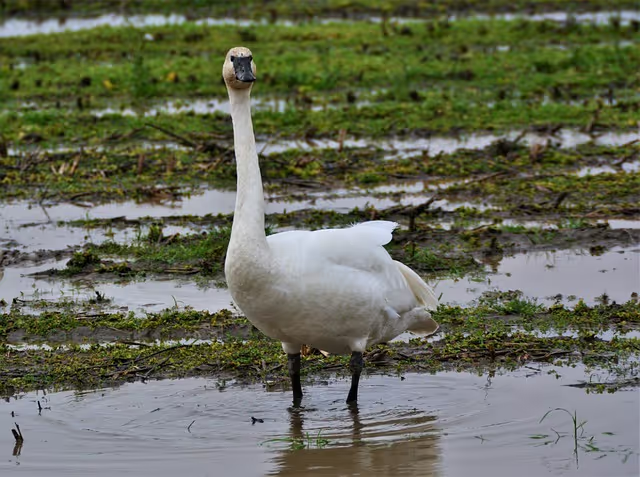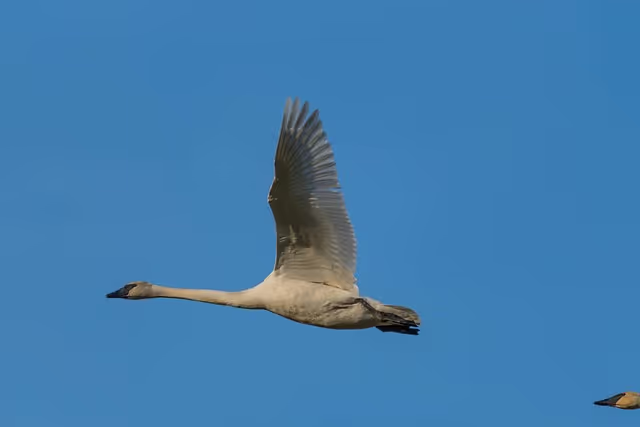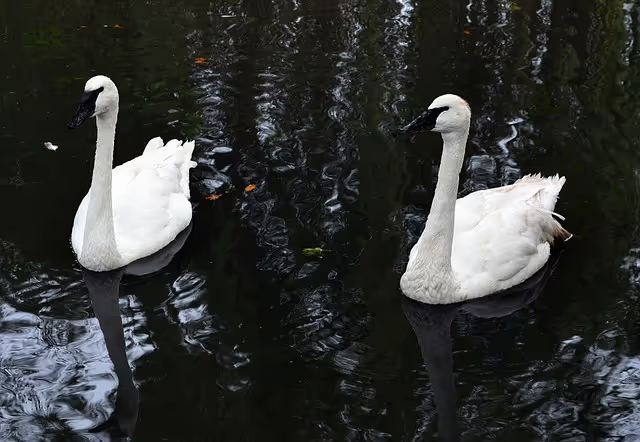Trumpeter Swans



Introduction and Habitat
Trumpeter Swans (scientific name: Cygnus buccinator) are some of the most extraordinary birds you will ever encounter. They are large, elegant, and loud (1, 4). After nearly being driven to extinction in the twentieth century, Trumpeter Swans have made a comeback that seems poised to continue, even as climate change threatens much of their existing range (3). The species currently spends its breeding seasons in Alaska, Northwestern Canada, Iowa, and in areas around the Great Lakes (1). During the winter, Trumpeter Swans move to coastal areas of Washington and British Columbia, as well as portions of the Great Plains, the Appalachian Mountains, and the Ozark Mountains of Missouri and Arkansas (1).
Trumpeter Swans prefer to be in wild habitats. This means that you are less likely to find them in urban areas. They like waterways that are fairly shallow, as well as agricultural fields (1). Here in Ocean Shores, your best chance to see Trumpeter Swans is most likely going to be along the city's many miles of canals. You may also be able to spot Trumpeter Swans along our region's rural rivers, as well in marshes, lakes, and shallow ponds. Furthermore, it was recently reported in the Centralia Chronicle that Trumpeter Swans have been showing up in Lewis County with the birds apparently looking for new winter habitats. Their arrival was well noted by local residents, as the "harsh and exciting" calls that Trumpeter Swans make could be heard "from miles away" (4).
Size and Take Off
Trumpeter Swans are the largest native waterfowl in the United States. As a result, they are fairly easy to spot. Members of both sexes have a wingspan of six to eight feet (4), and are up to six feet long (1). They typically weigh anywhere from 16 to 26 pounds, though males can sometimes weigh even more than that.
To become airborne, Trumpeter Swans have to take off in a "lumbering" style along an open water runaway that is at least 100 yards in length. As they run hard across the surface to generate the speed they need in order to take off, the noise they make will resemble that of galloping horses (1).

Appearance
All species of swans have elegant appearances, and Trumpeter Swans are no exception. Adult swans sport snowy-white plumages with black bills and black legs. Juveniles sport brown-gray plumages (2). Trumpeter Swans have long, graceful necks, which they hold in a straight position when they are in flight and on the water (1). Their bills are large, and slope down from their foreheads in a continuous manner (2). Trumpeter Swans can look somewhat awkward when they are on the ground. This is because they have short legs that are placed behind their center of gravity. While you might think that this would make walking difficult, they are actually fairly agile. Trumpeter Swans can walk more than one mile at a time. (1).
Mating and Nesting
Trumpeter Swans form bonded pairs when they are approximately three to four years old. Once two swans form a pair, they stay together throughout the year, moving together as part of migratory populations (1). While it is widely assumed that Trumpeter Swans mate for life, some swans will leave existing bonded pairs behind and form new bonded pairs over their lifetimes. Additionally, some males that lose their mates may choose not to mate again (1). The pairs begin making nests at around four to seven years of age. Their preferred nest sites are in open habitats that are surrounded by water, such as on small islands, floating platforms, beaver houses, or muskrat houses. The nest is built by both swans, although it is believed that females often do most of the work (3). The nest is normally a shallow mound of plant material that is several feet in diameter. The center of the nest features a "depressed bowl" (3). Trumpeter Swans may use the same nest for several years.
Eggs and the Young
Trumpeter Swans lay anywhere from four to nine eggs at a time. The eggs start out with a whitish color, but eventually become "nest-stained” (3). Pairs keep their eggs warm by covering them with their webbed feet. The female is normally the one to handle this process, but males often step in and help from time to time. The eggs hatch 32 to 37 days after they are laid (3). Both adult swans tend to their young by leading them to feeding sites. The young can swim on their first day of life, and their ability to fly begins to develop shortly thereafter. It takes approximately three to four months for the young to fully learn how to fly. (3).
Feeding and Diet
Trumpeter Swans typically forage for food in areas of fairly shallow water (1). Sometimes, they forage in deeper water and find food with their bills by touch (3). The Trumpeter Swan's normal diet consists of the leaves, roots, and stems of various aquatic plants, including arrowleaf, burreed, pondweed, sedges, and rushes. Young Trumpeter Swans eat many insects and other small invertebrates during their first two weeks of life before transitioning to the normal diet of aquatic vegetation (3). Trumpeter Swans also patronize agricultural fields to eat crops and grains that were left behind after the harvest season (1).
References
© Ian D. Caldwell, December 2022
Touch whale bones, examine shipwreck artifacts and connect with the coast's living history.

Support our mission, get involved in educational programs, or contribute through donations and volunteering.